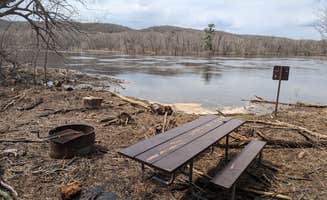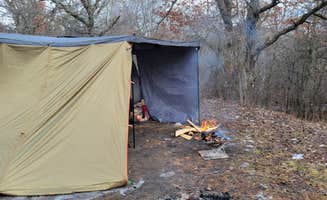South of Sand Dunes State Forest offers primitive camping in sandy terrain with pine stands approximately 60 miles northwest of Mahtomedi, Minnesota. The forest features a network of gravel roads with dispersed camping opportunities along county roads 233-237. Temperatures range from 10°F in winter to 80°F in summer, with spring and fall providing the most comfortable camping conditions.
What to do
Wildlife observation: Watch for sandhill cranes in open areas near campsites. "Stand storks are very protective. Stay away from them. They attack," warns a camper at South of Sand Dunes State Forest.
Hammock camping: The mix of pine trees creates ideal hammock hanging opportunities. One visitor notes, "I was able to walk in and find an incredible spot to camp and lay in my hammock."
River paddling: Access the St. Croix River at nearby dispersed sites. The area near Sandy Cove on the St. Croix River features "a pad at the bottom of the path up to the open air vault toilet, a fire ring, and a table" with "an extra long side for those in a wheelchair."
Bird watching: Listen for diverse bird species throughout the forest. One camper experienced "a nice quiet area" with "lots of different bird sounds" throughout their stay.
What campers like
Accessibility: The forest's proximity to the Twin Cities makes it convenient for weekend escapes. "I love that it's so close to home," shares one visitor to South of Sand Dunes State Forest.
Peace and quiet: Most sites offer tranquility once day traffic subsides. "A bit more traffic, but after 12 p.m., not much of anything. I really recommend this for an easy stop if you're looking for a place to put up. It's peaceful," notes a return visitor.
Vehicle access: Most dispersed camping areas accommodate standard vehicles. At County Road O Landing, campers find it "quiet and easy to find" with multiple parking options including spots "near the boat ramp and bathroom" or near the trailhead.
Site variety: The forest offers numerous pull-off spots with varying terrain. "There are a few spots that have great views or pull-through areas," explains a camper who appreciated the diversity of site options.
What you should know
Vehicle traffic: Some forest roads experience more traffic than expected. "This road is pretty busy for a dirt forest road and people FLY down it. Almost got hit a few times walking. Even through a Wednesday night cars are flying down the road."
Limited phone service: Most forest areas have poor connectivity. At County Road O Landing, campers report "1 bar of Verizon (no T-mobile service)" while sites deeper in the forest often have no service at all.
Wildlife hazards: Beyond mosquitoes and ticks, larger wildlife requires awareness. One camper encountered "what seemed to be a stray husky quickly roll through camp around dusk" while others report active bird species that can be territorial.
Law enforcement presence: County and DNR officers may interpret camping rules differently. "I had a county sheriff person tell me it's not lawful to park a trailer and they kicked me out. I called the dnr and they said that wasn't right but I decided to leave anyway."
Tips for camping with families
Morning wildlife walks: Schedule nature observation early to avoid traffic and heat. At County Road O Landing, families can wake up to "amazing bird calls" if they set up near wooded areas.
Accessible camping: Some sites offer features for diverse physical needs. Sandy Cove on the St. Croix River provides "a pad at the bottom of the path up to the open air vault toilet, a fire ring, and a table" with wheelchair accessibility.
Bug protection: Prepare children for mosquito season with proper clothing and repellent. One camper noted their experience was significantly impacted as "after 5mins of the door being opened and several flying in, we decided the area wasn't for us."
Water safety: If camping near the St. Croix River access points, establish clear boundaries for children. Sites along the river can experience flooding after "historic snowfall and thaw causing the river to flood," creating changing shoreline conditions.
Tips from RVers
Site selection for larger vehicles: Most forest roads accommodate smaller rigs but have limitations. "Great spot. Plenty of parking. Best for straight vehicles or very small trailers," advises a truck camper visitor.
Low clearance awareness: Watch for overhanging branches on access roads. One RVer reported, "We did find one we thought we liked, but branches over hung, and rested on our camper (8ft high) and in fact most sites were shaded."
Overnight options: Truck campers and smaller rigs find the area suitable for quick stays. "I just did an overnight camp one night in a truck camper and it was very easy to navigate and it was cleaned quiet area to spend the night."
Road conditions: Assess current terrain before committing to a site. "The road goes for a long ways, I parked near the front and closer to numbers, always like to be safer," shares one camper who prioritized ease of access over isolation.



